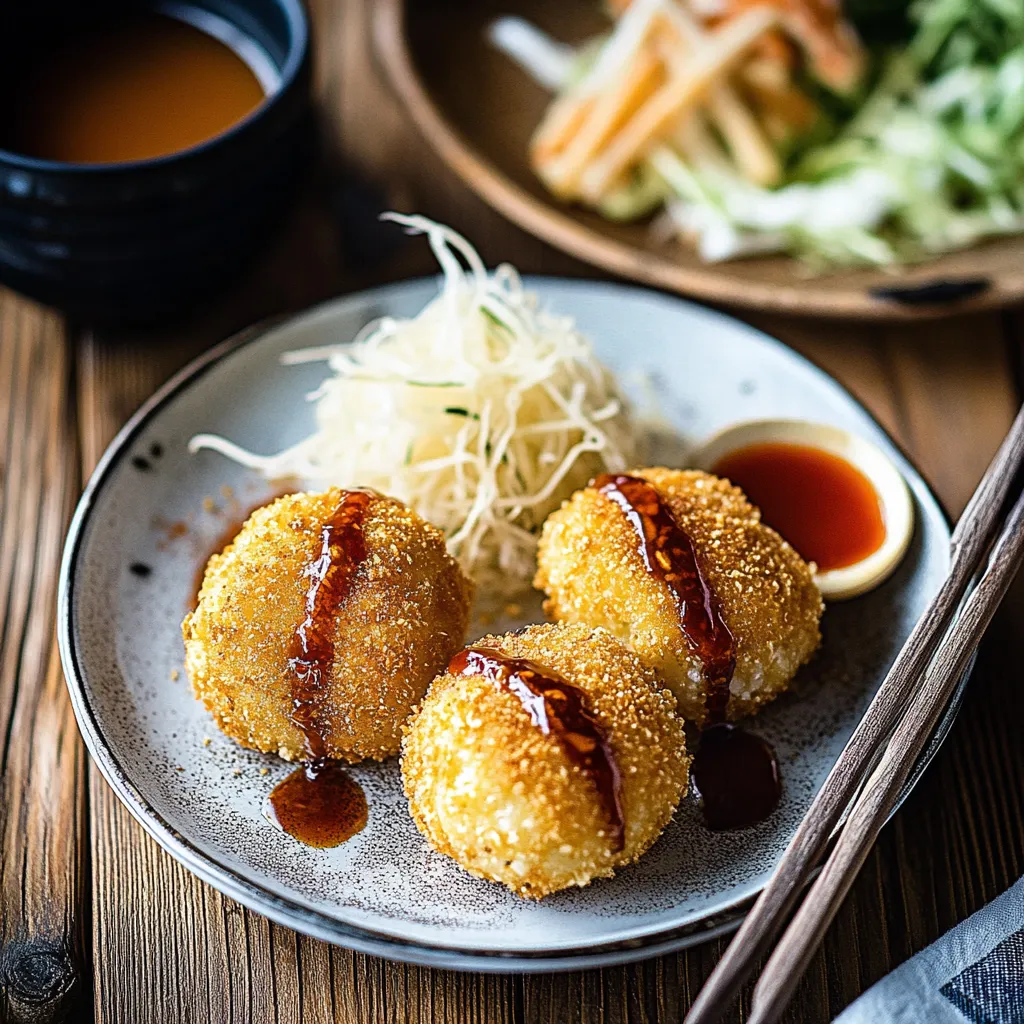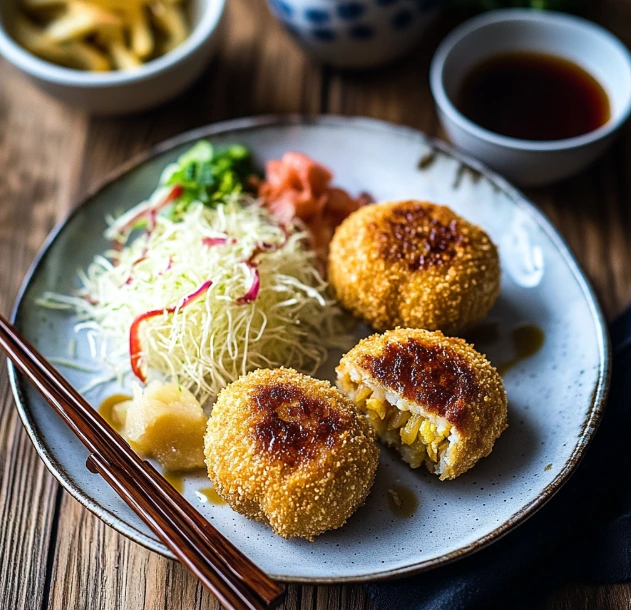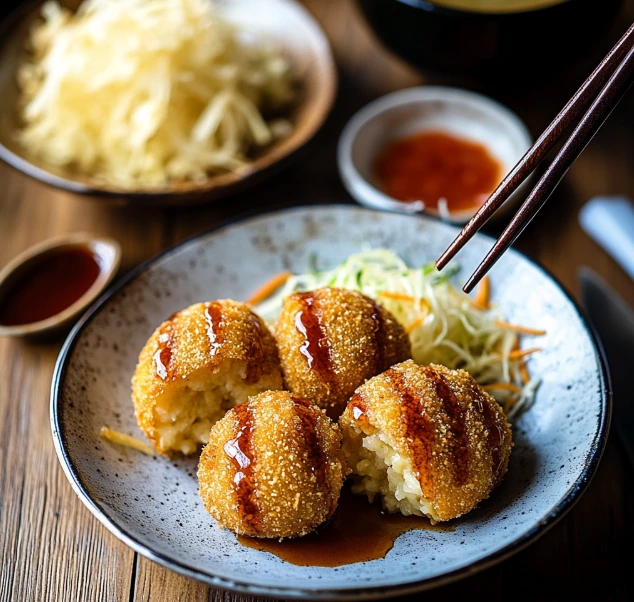 Pin it
Pin it
Korokke blends Japanese and Western flavors into one incredible comfort dish. Crack through the crispy panko shell to find warm, seasoned potatoes and meat inside. Every mouthful offers an amazing mix of textures - that satisfying outer crunch gives way to a soft, flavorful center that really captures what Japanese home cooking is all about.
As a kid in Japan, I'd watch my mom form each korokke with such skill - it taught me that food was a way to show you care. These days, whenever I hear panko sizzling in hot oil, I'm instantly back in her kitchen during those special times.
Key Ingredients Breakdown
- Russet potatoes: They've got loads of starch which makes them super fluffy and they soak up all the meat flavors brilliantly
- Premium ground beef: Go for 80/20 fat ratio so your korokke stays juicy and tasty
- Yellow onions: When you cook these right, they turn naturally sweet and add amazing flavor in every bite
- Japanese panko: Grab the real Japanese stuff for that incredibly light, airy crunch
- Neutral oil: Pick something with high smoke point like canola or vegetable to get that perfect golden outside
Making Stunning Korokke
- Potato Preparation:
- Begin with peeled potatoes in cold water. This old-school approach cooks them evenly throughout, avoiding that awful watery outside that can mess up your korokke texture.
- Onion Perfection:
- Cook your diced onions until they're deep gold, bringing out their sweetness. Keep going until there's no moisture left - this key step keeps your croquettes from getting soggy.
- Meat Enhancement:
- Toss your ground beef in with those golden onions, breaking it into tiny, uniform bits. Brown it thoroughly, letting all extra moisture cook off completely.
- Potato Integration:
- Mash those hot potatoes and slowly mix in your meat combo. The warm potato starch will grab onto those savory flavors, creating a more unified filling.
- Shaping Success:
- Use slightly damp hands to form oval patties without air bubbles. Each should be compact but not squashed - roughly palm-sized.
- Breading Brilliance:
- Set up a three-part coating station with flour, beaten eggs, and panko. Cover each cooled patty fully for that amazing crunch.
 Pin it
Pin it
In our house, making korokke was always something special. Mom would tell me, "It's not what goes in them that counts, but the care and time you spend on each step." Now when I make them, I try to copy her careful approach, remembering how she taught me to listen for just the right sizzle when the breaded patties hit the hot oil.
Managing The Heat
Getting your oil temp right makes or breaks your korokke. Too hot means dark outsides with cold middles. Too cool means oil-soaked croquettes. I find that checking with a wooden chopstick for gentle, small bubbles works better than just using a thermometer.
Prep Now, Cook Later
These little treats are perfect for making in big batches. Form and bread them, freeze them on a baking sheet, then pop them in freezer bags. They'll stay good for three months, and you can fry them straight from frozen - just cook them about a minute longer.
Classic Pairings
Back in Japan, we always eat korokke with thinly sliced cabbage and tonkatsu sauce. The fresh, crunchy cabbage balances out the rich croquettes, while the tangy sauce cuts through all that goodness perfectly.
Keeping Them Fresh
To keep your korokke crunchy, put them on a wire rack instead of paper towels after frying. If you're making them ahead, let them cool all the way before storing them with parchment paper between layers in an airtight container.
 Pin it
Pin it
After countless times making these beloved croquettes, I've found that taking your time really does make them perfect. Every stage builds on the last, from boiling potatoes to getting that beautiful golden-brown exterior. Whether it's just a quiet family dinner or a big get-together, these korokke carry all the warmth and love that makes Japanese home cooking so special.
Frequently Asked Questions
- → Why do the patties need to be chilled before frying?
- Cooling them down stops steam from forming inside while they cook, which might make them burst open and break their crispy outer layer.
- → Can I make these ahead and freeze them?
- Sure thing, you can freeze cooked croquettes for up to a month. Just warm them up in a 350°F oven for 45 minutes from frozen, or 15-20 minutes if they're thawed first.
- → Why use russet potatoes specifically?
- Russet potatoes work best because they're fluffy and starchy, so they soak up all the tasty flavors from the meat and onions while staying light and airy.
- → What's the best oil temperature for frying?
- Keep your oil between 340-350°F (170-180°C) to get that perfect golden outside without burning them.
- → What's traditionally served with Korokke?
- People usually eat Korokke with tonkatsu sauce and thinly sliced cabbage. Some folks add tomato chunks for a pop of color too.
